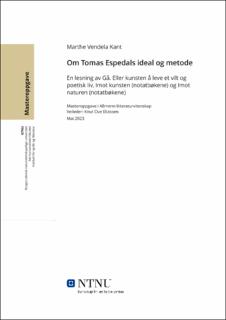| dc.contributor.advisor | Eliassen, Knut Ove | |
| dc.contributor.author | Kant, Marthe Vendela | |
| dc.date.accessioned | 2023-07-11T17:21:36Z | |
| dc.date.available | 2023-07-11T17:21:36Z | |
| dc.date.issued | 2023 | |
| dc.identifier | no.ntnu:inspera:138868970:38231570 | |
| dc.identifier.uri | https://hdl.handle.net/11250/3077833 | |
| dc.description.abstract | Denne masteroppgaven er en lesning av Tomas Espedals romaner Gå. Eller kunsten å leve et vilt og poetisk liv (2006), Imot kunsten (notatbøkene) (2009) og Imot naturen (notatbøkene) (2011). Den litteraturhistoriske interessen som kommer til uttrykk i Espedals romaner, synes for meg å ha et tydelig ekko av tradisjonen, slik den beskrives av T. S. Eliot i essayet «Tradition and the Individual Talent» (1919). Espedal er både bevisst om tradisjonen og går i dialog med denne. Samtidig benytter han seg av flere litterære grep som markerer dette, blant annet i form av paratekster, intertekstualitet og metatekstualitet, slik begrepene formuleres av Gérard Genette (1982/1987). I min lesning har jeg vektlagt de utallige referansene til andre forfattere og verk, som foreligger i romanene. Referansene dukker opp i form av sitater, anekdoter, sammenligninger, ulike lesninger, etablerte topoi og det Roland Barthes (1977) omtaler som «figurer». Min inngang er Eliots formulering om at ingen kunstner får sin fulle betydning dersom han betraktes isolert. I analysen, som er bygd opp med utgangspunkt i 12 motiver og figurer som er gjennomgående i forfatterskapet, argumenterer jeg for at romanene, gjennom de ulike referansene, formulerer forfatterens poetiske ideal og litterære metode. Jeg anser idealet og metoden som kommer til uttrykk i de tre romanene, som å være sterkt forankret i forbildene og i idéen om å skrive i forlengelse av en tradisjon. | |
| dc.description.abstract | This master’s thesis is a read of Tomas Espedal’s novels Tramp. Or the Art of Living a Wild and Poetic Life (2006), Against Art (2009) and Against Nature (2011). The literary-historical interest expressed in Espedal’s novels seems to have a clear echo of tradition, as described by T. S. Eliot in the essay “Tradition and the Individual Talent” (1919). Espedal is concious of the tradition, and engages in dialogue with it. Simultaneously, he employs several literary techniques highlighting this, such as paratexts, intertextuality and metatextuality as conceptualized by Gérard Genette (1982/1987). In my interpretation of Espedal I have emphasized the innumerable references to other authors and works, which is present in his novels. The references appear in the form of quotes, anecdotes, comparisons, various interpretations, established topoi and Roland Barthes’ (1977) descriptions of “figures”. My approach is based on Eliot’s statement that no artist can be fully understood if considered in isolation. Through the analysis, which is based on 12 motifs and figures recurring throughout the authorship, I argue that the novels, through their various references, embody the author’s poetic ideal and literary method. I consider the ideal and method expressed in these three novels to be firmly rooted in Espedal’s literary role models and the idea of writing in continuation of a tradition. | |
| dc.language | nob | |
| dc.publisher | NTNU | |
| dc.title | Om Tomas Espedals ideal og metode. En lesning av Gå. Eller kunsten å leve et vilt og poetisk liv, Imot kunsten (notatbøkene) og Imot naturen (notatbøkene) | |
| dc.type | Master thesis | |
